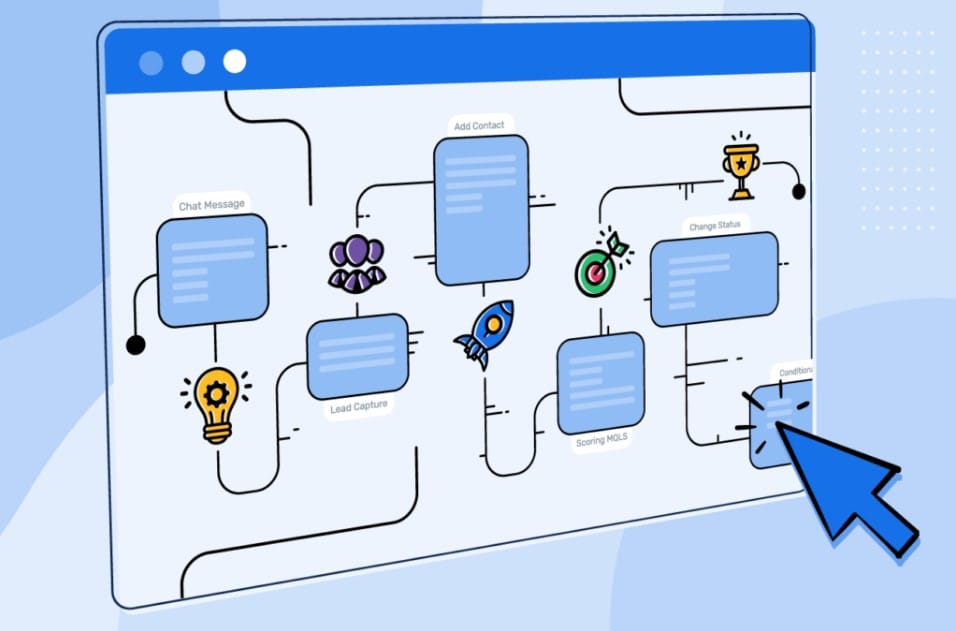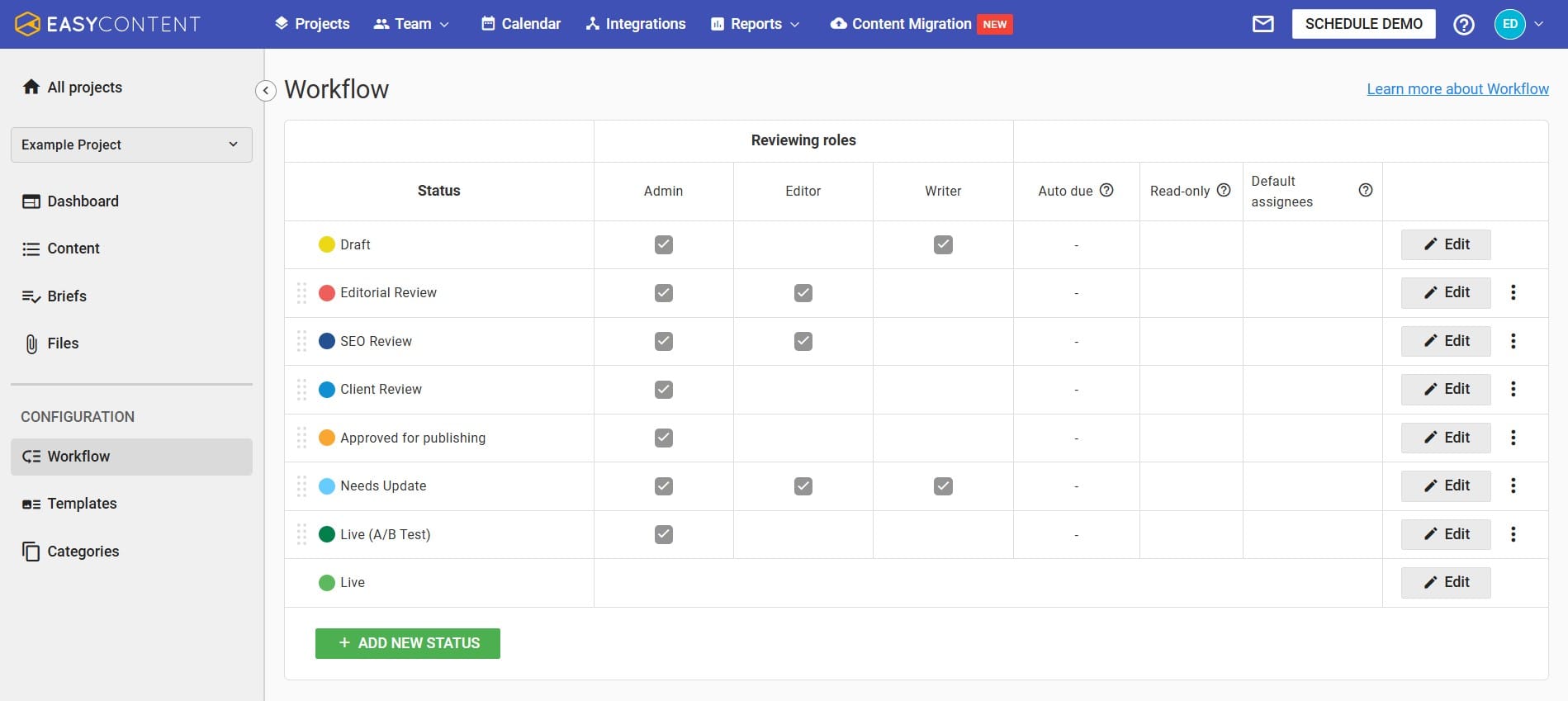How to Streamline Content Production and Prevent Team Burnout
Content teams often struggle with poor processes, unclear roles, and chaotic collaboration. EasyContent solves these issues through centralized management, automation, and clear workflows, enabling higher productivity without stress, chaos, or sacrificing content quality.

Creating high-quality content consistently is the dream of every content team. But in reality, it often feels like an uphill battle - tight deadlines, scattered communication, and never-ending revisions can turn what should be a creative process into a stressful, chaotic one. Teams discover they are drowning in last-minute rushes, approval bottlenecks, and exhaustion rather than creating interesting material.
What then is the real problem? poor practices and lacking coherent systems. Lack of a clear method for idea, development, editing, and approval causes content teams to run across difficulties. Project managers fight to keep things on schedule, editors rush to meet deadlines, while writers wait for never occurring comments. The outcome is... Missed deadlines, uneven quality, and a workforce strained unable to perform as it could have.
It is not necessary, though, that it be this way. Most effective content teams work smarter rather than harder. They have defined responsibilities, organized processes, and the correct instruments to maintain seamless operation of everything. And that's precisely what this blog is about, helping you discover the secrets to a high-performance content team that generates more material without the stress.
Using a centralized content management system like EasyContent marks one of the largest changes in this approach. EasyContent gathers all of the material into one location unlike conventional document-sharing systems that leave items strewn over several files and email threads. Without needless delays or uncertainty, writers, editors, and project managers can work easily together, monitor approvals simply, and guarantee material flows naturally from draft to publication.
In this blog, we’ll explore proven strategies to help your team:
- Increase content output without sacrificing quality.
- Simplify processes, approvals, and teamwork.
- By besting task management, lower burnout and stress.
- Work more effectively by using correct tools and techniques.
Your content team should be using another strategy if they discover they are continually feeling overburdled. While maintaining a content team that is joyful, involved, stress-free, let's learn the secrets of a great content team and find out how easily you can enhance your content projects.
The Challenges of Content Production Overload
Though in principle creating high-quality content sounds fantastic, in fact content creation may rapidly spiral out of hand. Teams are routinely juggling several projects, chasing approvals, and rushing to meet deadlines - all while striving to preserve content quality. When processes aren’t streamlined, it leads to bottlenecks, endless revisions, and burned-out team members.
If your team is feeling overwhelmed, you’re not alone. Many content teams struggle with content production overload due to unclear workflows, lack of structured collaboration, and poor planning. Let’s break down the most common challenges and how to fix them.
1. Unclear Workflows: The Silent Productivity Killer
A content team without a structured workflow is like a ship without a captain - everyone is working, but no one knows exactly where they’re headed. When roles and responsibilities aren’t clearly defined, tasks take longer than they should, and content gets stuck in endless loops of uncertainty.
Some telltale signs of unclear workflows include:
- Writers waiting too long for feedback because no one knows who should approve drafts.
- Editors spending hours searching for the latest version of a document.
- Content managers constantly following up on tasks because there’s no structured tracking system.
🔹 How EasyContent Helps: EasyContent eliminates workflow confusion by centralizing content creation. Writers, editors, and managers can see exactly where a piece of content stands, what needs to be done next, and who is responsible - all in one place.
2. Constant Revisions: The Never-Ending Feedback Loop
Revisions are a natural part of content creation, but when there are no clear guidelines, they can quickly get out of hand. Some drafts go through five, ten, or even more rounds of edits before publication - wasting time and delaying production.
Common causes of excessive revisions include:
- Lack of a content style guide, leading to inconsistent writing.
- Editors and stakeholders leaving conflicting feedback.
- No structured approval system, causing drafts to get stuck in endless review cycles.
🔹 How EasyContent Helps: EasyContent streamlines the revision process by keeping feedback organized and centralized. Instead of chasing edits across multiple emails, team members can leave comments directly on drafts, making revisions clear and actionable.
3. Missed Deadlines: The Domino Effect of Poor Planning
Deadlines exist for a reason, but when content projects aren’t properly planned, everything turns into a last-minute rush. Writers scramble to finish drafts, editors rush through revisions, and content managers stress over delayed approvals.
Why do teams miss deadlines?
- Poor task management - team members aren’t assigned clear deadlines.
- Delayed feedback and approvals slow down the entire workflow.
- Overloaded writers and editors struggling to keep up with demand.
🔹 How EasyContent Helps: With automated task assignments, deadlines, and approval reminders, EasyContent keeps content production on track. No more last-minute stress, every team member knows what needs to be done and when.
4. Team Burnout: The Price of Overloaded Workloads
When a content team is constantly playing catch-up, it’s only a matter of time before burnout sets in. Creativity declines, productivity drops, and team morale takes a hit. Overloaded team members may struggle with:
- Mental exhaustion from juggling too many tasks at once.
- Loss of motivation, leading to lower-quality content.
- Increased turnover, as employees feel overworked and undervalued.
🔹 How EasyContent Helps: By streamlining content production and reducing unnecessary workload, EasyContent allows teams to work smarter, not harder. With structured workflows and task automation, content teams can focus on creativity without feeling overwhelmed.

Setting Up a Smooth and Scalable Workflow
Developing excellent material is more than simply writing; it's about following a disciplined approach guaranteed by scalability, consistency, and efficiency. Content creation may go wild without a defined methodology, resulting in missed deadlines, disjointed drafts, and overburdened staff.
To build a stress-free content production system, teams need a workflow that is organized, scalable, and easy to follow. Whether you’re a small team looking to grow or managing a large-scale content operation, here are three key steps to setting up a smooth and efficient workflow.
1. Define a Standardized Content Process
Content production might seem unorganized and daunting without a disciplined approach. While some teams start right away in writing, others take too much time in planning. Efficiency depends on clearly delineating from conception to publishing the actions needed.
Here’s an example of a standardized content workflow:
Ideation - Brainstorming topics based on SEO research, audience needs, and marketing goals.
Content Briefing - Defining the purpose, target audience, keywords, and key takeaways.
Drafting - Writers create content based on the brief.
Editing & Feedback - Editors refine content for clarity, consistency, and brand alignment.
Approval Process - Stakeholders review and finalize the piece.
Publishing & Distribution - The content goes live and is shared across platforms.
🔹 How EasyContent Helps: EasyContent allows teams to set up a structured content workflow, ensuring every step is followed consistently. Writers, editors, and project managers can track progress, assign tasks, and streamline approvals - all in one place.
2. Use a Centralized Content Platform
Managing content through emails, spreadsheets, and random Google Docs is a recipe for disaster. When files are spread across different tools, it becomes difficult to track progress, maintain consistency, and collaborate efficiently.
A centralized platform ensures that:
All drafts, revisions, and approvals are stored in one place.
Team members can collaborate in real time without confusion.
Content moves smoothly from one stage to the next without unnecessary delays.
🔹 How EasyContent Helps: Instead of juggling multiple tools, EasyContent brings everything into a single platform. It allows teams to create, edit, review, and approve content without switching between apps, ensuring seamless collaboration and better content organization.
3. Implement an Editorial Calendar
A well-organized editorial calendar helps teams plan content in advance, preventing last-minute stress and ensuring a steady flow of content. Without a calendar, teams often end up rushing to create content, leading to lower quality and inconsistent publishing schedules.
An editorial calendar should include:
Publishing dates - Schedule content releases in advance.
Content topics and formats - Blog posts, social media, case studies, etc.
Assigned writers and editors - Clearly define responsibilities.
Deadlines for each stage - Drafting, editing, approvals, and publishing.
🔹 How EasyContent Helps: EasyContent comes with built-in task management and scheduling tools, making it easy to set deadlines, assign roles, and track progress. Teams can visualize their entire content pipeline and ensure that content is published on time, every time.
Smart Task Distribution: Play to Your Team’s Strengths
A well-organized content team doesn’t just happen by chance, it’s the result of smart task distribution that leverages everyone’s strengths. Without clear roles, work can get bottlenecked, deadlines slip, and team members end up overworked or underutilized.
The secret to a high-performing content team isn’t about pushing everyone to do more, it’s about ensuring that the right people are handling the right tasks while using automation to remove unnecessary manual work. Here’s how to distribute tasks effectively and keep your team working at peak efficiency.
1. Clearly Define Roles to Avoid Overlaps and Confusion
One of the biggest challenges in content production is role ambiguity. When writers, editors, and project managers aren’t sure who is responsible for what, tasks fall through the cracks, or worse, get duplicated.
Every content team should have clearly defined roles, such as:
- Writers - Focus on research, writing, and structuring content.
- Editors - Refine drafts, ensure consistency, and maintain quality standards.
- Strategists - Plan content topics, optimize for SEO, and align content with marketing goals.
- Project Managers - Oversee timelines, assign tasks, and ensure deadlines are met.
When each role is clearly outlined, team members know exactly what’s expected of them, and there’s no unnecessary overlap.
🔹 How EasyContent Helps: EasyContent allows managers to assign roles within the platform, ensuring that writers, editors, and strategists can see their specific tasks without confusion. Everything is mapped out in a structured workflow, keeping projects moving smoothly.
2. Delegate Effectively to Keep Workloads Balanced
It’s easy for content teams to fall into the trap of overloading certain team members while others wait around for tasks. A productive team operates like a well-oiled machine, with work evenly distributed based on expertise and availability.
Effective delegation means:
- Distributing workloads fairly so no one is overwhelmed.
- Matching tasks to team members’ strengths - give writing-heavy assignments to writers and strategy-driven tasks to planners.
- Avoiding bottlenecks by ensuring multiple people can review or approve content if someone is unavailable.
🔹 How EasyContent Helps: With EasyContent’s task management system, team leads can see each member’s workload at a glance and distribute tasks evenly. This ensures that no single person is stuck with too much work while others are waiting for their next assignment.
3. Use Automation for Repetitive Tasks and Follow-Ups
One of the biggest time-wasters in content production is chasing approvals, sending reminders, and tracking deadlines manually. Instead of spending hours on repetitive admin work, automation can handle these tasks, freeing up time for creativity and strategy.
Here’s how automation can boost productivity:
- Automated reminders keep deadlines on track, reducing the need for follow-ups.
- Task assignments can be pre-set based on workflows, ensuring smooth handoffs.
- Approval notifications notify the right people when content is ready for review, eliminating delays.
🔹 How EasyContent Helps: EasyContent automates task assignments, reminders, and approvals, so team members always know what’s next - without needing constant manual follow-ups.

Collaboration Without Chaos: How to Improve Team Communication
Excellent authors and editors alone define a good content team; it also reflects flawless cooperation. Teams too frequently find themselves caught in extended email threads, scattered comments, and never-ending editing cycles, too. Rather than functioning effectively, they are caught in communication bottlenecks slowing down everything.
The solution? Better communication practices and the right tools. By streamlining how your team shares feedback, aligns on goals, and manages revisions, you can turn content production into a smooth, stress-free process. Here’s how to collaborate effectively without the chaos.
1. Avoid Long Email Threads - Use Direct Collaboration Tools
Let’s be honest, email is one of the worst places for content collaboration. Conversations get buried, feedback gets lost, and before you know it, you’re scrolling through 50+ replies just to find one comment.
Instead of cluttering inboxes, teams should:
1.Use a centralized platform where all discussions and revisions stay organized.
2.Tag team members directly for feedback instead of sending group emails.
3.Keep track of changes in one place rather than juggling multiple document versions.
🔹 How EasyContent Helps: With EasyContent, teams can leave direct comments on drafts, track revisions, and tag colleagues for feedback - all in one place. No more messy email chains or confusion about which version is the latest!
2. Schedule Regular Check-Ins to Keep Teams Aligned
Miscommunication often happens when teams assume everyone is on the same page, but in reality, people may have different priorities, unclear expectations, or unresolved roadblocks.
Regular team check-ins help by:
- Clarifying content goals and deadlines so everyone knows what to focus on.
- Identifying roadblocks early, preventing unnecessary delays.
- Keeping remote teams connected, ensuring smooth collaboration.
These meetings don’t have to be long, a 15-minute weekly sync is enough to align on progress and address any concerns.
🔹 How EasyContent Helps: EasyContent provides a shared workspace where team members can see content status, upcoming deadlines, and pending approvals so even between check-ins, everyone stays in the loop.
3. Streamline Feedback and Revisions to Prevent Bottlenecks
Feedback is essential to great content, but when it’s scattered across emails, Slack messages, and handwritten notes, it creates confusion, delays, and frustration. A structured feedback system makes sure that:
- Writers receive clear, consolidated feedback instead of multiple conflicting suggestions.
- Editors and managers can approve content efficiently without unnecessary back-and-forth.
- All feedback is tracked in one place, ensuring revisions are made correctly the first time.
🔹 How EasyContent Helps: EasyContent built-in approval workflow keeps feedback organized, structured, and easy to follow. Writers and editors can see exactly what needs to be changed, track progress, and keep content moving forward, without endless revision cycles.
Prioritizing Quality Without Slowing Down Production
Content production always requires a careful mix between speed and quality. Although you want material published often, speeding through the process could result in errors, poor message, and brand reputation loss. Conversely, concentrating too much on making every item flawless could slow down manufacturing and lead to delays and lost opportunities.
So, how do you ensure high-quality content without creating bottlenecks? The answer lies in structured processes, smart automation, and data-driven optimization. Here’s how to maintain quality standards while keeping content production efficient.
1. Use Content Templates to Streamline Creation
Starting from scratch with every new piece of content wastes time and creates inconsistencies. That’s where content templates come in handy. By using standardized formats, teams can:
- Speed up the writing process while maintaining quality and structure.
- Ensure brand consistency by following a pre-approved format.
- Reduce editing time since content follows a clear and familiar structure.
For example, a blog post template might include sections like Introduction, Key Points, Case Study, Conclusion, and CTA, ensuring that all content pieces follow a logical flow.
🔹 How EasyContent Helps: EasyContent allows teams to create and store custom content templates, making it easy for writers to start with a consistent format and stay aligned with brand guidelines.
2. Establish a Multi-Step Editing Process
One of the biggest threats to content quality is rushing the editing phase - or worse, skipping it altogether. A structured, multi-step review process ensures that every piece of content is error-free, well-structured, and polished before publication.
Here’s a simple 3-step editing process that keeps quality high without slowing things down:
- Peer Review: Another writer or editor does an initial check for clarity and coherence.
- Editor’s Pass: A professional editor refines grammar, tone, and brand alignment.
- Final Approval: The content manager or stakeholder gives the green light before publishing.
This process reduces mistakes, ensures consistency, and prevents unnecessary back-and-forth revisions.
🔹 How EasyContent Helps: With EasyContent’s approval workflow, teams can set up a structured review process, assign editors, and track revisions - all in one place. No more scattered feedback or endless revision loops!
3. Track Performance Metrics to Continuously Improve
You can’t improve what you don’t measure. Tracking key content performance metrics helps teams refine their strategy, optimize content formats, and improve efficiency over time.
Some key metrics to monitor:
- Engagement Rates - Are people actually reading and interacting with your content?
- Time Spent on Page - Is your content holding readers’ attention?
- Conversion Rates - Is the content driving leads, sales, or other desired actions?
- Editing & Approval Time - Are there bottlenecks in your workflow that need fixing?
By analyzing this data, teams can identify areas for improvement, tweak content strategies, and refine workflows to make production even more efficient.
🔹 How EasyContent Helps: EasyContent provides content tracking and workflow insights, allowing teams to see how long each step takes and where bottlenecks happen - helping them continuously optimize their process.
The Role of EasyContent in Creating a More Productive Team
Sometimes running a content team feels like herding cat - emails flying everywhere, drafts missing, comments spread over several platforms, and deadlines often changing. The secret to a really effective content team is not just diligence but also the correct mechanisms in place to maintain everything orderly, automated, and operating without faults.
That’s where EasyContent comes in. Unlike generic tools that only focus on document collaboration, EasyContent is built specifically for content teams, helping them streamline their workflows, improve efficiency, and eliminate bottlenecks. Here’s how EasyContent helps teams stay productive without the chaos.
1. Centralized Content Hub: One Place for Everything
Maintaining organization during content management is one of the toughest tasks involved. One might easily lose sight of development between several versions of the same document floating about, input spread throughout email chains, and drafts kept in several files.
With EasyContent, teams can:
- Manage all content in one platform, from ideation to publication.
- Eliminate version confusion - everyone works on the latest draft.
- Streamline approvals without bouncing between different tools.
Everything related to content - tasks, drafts, approvals, and revisions, is stored in one structured space, ensuring smooth collaboration and zero confusion.

2. Automated Workflows: Work Smarter, Not Harder
One of the biggest productivity killers for content teams is manual follow-ups. Writers are left wondering when their content will be reviewed, editors are buried under multiple revision requests, and project managers are constantly reminding people about deadlines.
EasyContent automates these repetitive tasks, allowing teams to:
- Set up custom workflows that automatically move content through different stages.
- Send automated reminders when an approval or revision is due.
- Reduce unnecessary back-and-forth, keeping projects moving forward effortlessly.
By automating the approval process, teams can focus on creating high-quality content instead of chasing emails and waiting for updates.
3. Real-Time Collaboration: Keeping Everyone Aligned
Collaboration is the heartbeat of a successful content team, but when communication is scattered, it leads to missed feedback, delays, and frustration.
With EasyContent’s built-in collaboration tools, teams can:
- Leave direct comments on drafts instead of using messy email threads.
- Tag teammates for feedback or approvals, ensuring no task gets overlooked.
- Track real-time progress, so everyone knows what’s done and what’s pending.
This real-time collaboration keeps writers, editors, and project managers aligned, ensuring that content moves through the pipeline without bottlenecks or miscommunication.
Streamline, Collaborate, and Grow
A strong content team is about working smarter than about working longer hours or applying more effort. Excellent, continuous content creation calls not just skill but also a well-organized approach, flawless teamwork, and appropriate tools to keep everything under control.
Teams without adequately defined processes find themselves missing deadlines, dealing with disorganized feedback, and squandering time on recurring tasks. Apart from reduced production, this results in tension, tiredness, and different content quality. Success depends on efficiency, that is, knowledge of exactly what has to be done, who is in charge of what, and how to maintain the natural flow of initiatives intact.
At that moment, EasyContent makes all the difference. Unlike traditional document-sharing solutions that just offer basic cooperation, EasyContent is developed for content teams uniting content planning, task management, approvals, and real-time communication into one unified workspace. Teams may eliminate anarchy and focus on creating excellent stuff by means of automated processes, well-organized feedback loops, and exact content monitoring.
By using EasyContent, teams can:
- Simplify their whole process, covering ideation through publishing.
- Automate reminders and approvals, therefore reducing pointless follow-up.
- Clearly defined roles and real-time feedback help to improve teamwork.
- Scale materials creation without sacrificing standards or overloading the staff.
If your content staff is always feeling overburdened, it's time to rethink things. Productivity is about simplifying, accelerating, and optimizing the work—not about doing more. With the right approach, content teams can create outstanding content at scale without superfluous work.
Ready to take your content workflow to the next level? Try EasyContent today and see how effortless content management can be.






